|
Today in New Orleans History |
|
|
April 13


 Cosimo Matassa Photo from the Louisiana Endowment for the Humanities Born
in New Orleans on April 13, 1926, Cosimo Matassa is the recording engineer and studio owner responsible for nationally renowned
R&B and rock and roll recordings at his New Orleans studios. Matassa described himself simply as a "sound engineer"
in a July 19, 1981 Times-Picayune article written by John Pope. He went on to say that his formula for success was not
complicated in any way..."Do it live or do it over again until it was done right". He did it right for hundreds
of young unknown musicians including Ray Charles, Fats Domino, Mac Rebbenack (Dr. John), Mickey Gilly and so many more from
1945 through 1968 in his studio in the Quarter and later in the Central Business District. J&M recorded Alan Toussaint's
first record, "The Wild Side of New Orleans" which was released by RCA Victor. He recorded Aaron Neville's
"Tell it Like it Is", Robert Parker's "Barefootin'", and Little Richard's "Tutti Frutti" in
1956 -- a recording which has been acclaimed as a seminal Rock and Roll song. Cosimo Matassa was an
18 year-old second-year chemistry major at Tulane during World War II who quit school because he thought he would be drafted
into military service. But the war soon ended and he drifted into the music industry by taking a job involvling juke
boxes which led to an interest in records which led to invlovement with his father's J&M Music Shop on the corner of Rampart
and Dumaine which evolved into his first studio in 1945 in a back room of the store which was named for his dad, John
Matassa and his partner Joe Mancuso. In 1955, Cosimo moved to the larger Cosimo Recording Studio in
the CBD. Here, as engineer and proprietor, he was crucial to the development of the R&B, rock and soul sound of the 1950s
and 1960s, often working with producers Dave Bartholomew and Allen Toussaint. He recorded hits by Fats Domino’s
"The Fat Man" (another contender for the first rock and roll record), Little Richard's "Tutti Frutti",
and records by Ray Charles, Lee Dorsey, Dr John, Smiley Lewis, Bobby Mitchell, Tommy Ridgley, the Spiders and many others.
He was responsible for developing what became known as the "New Orleans Sound", with strong drums, heavy guitar
and bass, heavy piano, light horn sound and a strong vocal lead. In the late 1950s and early 1960s, Matassa also managed
the successful white New Orleans rock and roll performer Jimmy Clanton. He retired from the music business
in the 1980s to manage the family's food store, Matassa's Market in the French Quarter. In December 1999, J&M Recording
Studio was designated as an historic landmark by the Orleans Parish Landmarks Commission. In October 2007, Matassa was honored
for his contributions to Louisiana music with induction into The Louisiana Music Hall of Fame. On September 24, 2010, the
Rock and Roll Hall of Fame and Museum designated Cosimo Matassa’s original J&M Recording Studio as an historic Rock
and Roll Landmark, one of 11 nationwide. The studio is now a laundromat. Matassa was inducted
into the Rock and Roll Hall of Fame during its 27th annual ceremony on April 14, 2012. In 2013, he was inducted
to the Blues Hall of Fame.  

To receive an update for each day in New Orleans
history, join our facebook page
- Today in New Orleans History
Already a member of the New Orleans chapter
of the League of Women Voters, Keller began her foray into the world of politics working on voter registration. When her mother
died in 1945, Keller was asked to serve on the local YWCA board, an integrated organization that deeply impacted her views
on race relations. In 1947, seeking to alleviate the housing shortage for New Orleans’s black families, Rosa and Charles
Keller, along with friends and philanthropists Edith and Edgar Stern, financed the construction of Pontchartrain Park, one
of the first middle-class black communities in the country.
Keller expanded her political involvement in the early 1950s when she helped organize the Independent Women’s
Organization, created to support the election of moderate mayoral candidate deLesseps Morrison. When Morrison asked Keller
to serve on the board of the public library system, she readily accepted, becoming the first woman to serve on a citywide
board. Almost immediately Keller brought controversy to her position when she set out to integrate the New Orleans public
library system—a goal she eventually achieved. Keller continued to serve the New Orleans black community in a
variety of ways. She chaired the board of Flint-Goodridge Hospital, a facility that catered to the black community. In this
capacity, she fought for and won access to Blue Cross coverage for the New Orleans black community, and insisted that African
American medical students have access to New Orleans’s medical libraries. Keller also served as president of the New
Orleans Urban League, and on the boards of numerous citywide interracial organizations. In 1953, Keller decided that
it was time the League of Women Voters, an organization she loved, begin the process of admitting black members. With the
help of her progressive peers, she succeeded in integrating the organization in 1955. State laws passed in the wake of the
U.S. Supreme Court’s decision in Brown v. Board of Education, however, forced to the league to resegregate a year later.
Through Keller’s persistence, the league permanently achieved integrated status in 1963. In 1958 Keller led
the fight to desegregate the New Orleans public transportation system, but she considered her efforts to integrate the city’s
public schools as “her war.” Toward this end, Keller helped create Save Our Schools (SOS), an organization dominated
by elite white women in the New Orleans community. During the 1960 New Orleans School Crisis, when the first black children
attended formerly all-white schools, SOS ferried children to and from the integrated schools. They also raised monies for
the black and white families who kept their children in the schools and lobbied the state legislature on behalf of integrated
schools. Much to the chagrin of some family members, Keller also personally financed the legal fight to desegregate Tulane
University in 1963. Through the years, Rosa Keller had no qualms about holding interracial gatherings in her Uptown home,
though it was considered a serious breach of racial etiquette at the time. Keller received numerous honors for her
work on racial issues in New Orleans, including the Times-Picayune Loving Cup Award, which honors New Orleans residents who
have worked unselfishly for the community without expectation of public acclaim or material reward. She also received an honorary
alumnus degree from Newcomb College and an honorary doctorate from Dillard University. She died in April 15, 1998, in New
Orleans. The Keller Family Foundation, established in 1949, continues to provide monies to sustain and improve the New Orleans
community. The Rosa F. Keller Library & Community Center at 4300 S. Broad was named for her on October 6, 1999 Frystak,
Shannon. "Rosa Keller." KnowLA Encyclopedia of Louisiana. Ed. David Johnson. Louisiana Endowment for the Humanities,
31 Jan. 2011. Web. 20 Nov. 2013. His mother died when he was only twelve years old, after having
sold out the small stock of goods at the French Market. Martin Behrman, later secured a place as cashier at $15.00 per
month at Samuel’s Dollar Store on Canal Street. In 1878 Mr. Michael Gallagher of Algiers, Louisiana offered him a
position as grocery clerk. He left Gallagher to work for James Lawton, father of Peter Lawton, in a large mercantile establishment
which included a grocery, a bakery and did considerable business with the planters along the river.
At the age of 22, he met Miss Julia Collins of Cincinnati, Ohio, whom he married in 1887. About that time he went into
the retail grocery business with Peter Lawton, in Algiers. He soon gave up this business and became a city salesman for
Nathaniel D. Wallace and Napoleon Bonaparte Van Horn, wholesale dealers in produce. His last business connection was with
the firm of C. Doyle & Co. Through the influence of Colonel Charles C. Bird of Baton Rouge, Mr. Behrman ran for the office of State
Auditor and was subsequently elected. In 1904 he was elected Mayor of the City of New Orleans for the first time. He took
office on November 6, of that year. His second term as mayor began on November 3, 1908 and his inauguration took place
on December 7, 1908. Mayor Behrman was again elected for his third term on October 2, 1912. He took office on December
1, 1912 and his term expired December 4, 1916. He was elected for the fourth time without opposition on November 7, 1916,
and remained in office until December 6, 1920 when Andrew J. McShane became Mayor of the city. Again in 1925, Martin Behrman
ran for mayor being opposed by Paul H. Maloney and Andrew J. McShane. A second primary became necessary owing to the closeness
of the count, but was not called due to Mr. Maloney withdrawing from the race. Martin Berhman was conceded the election on
Monday, April 13, 1925, taking office May 4, 1925. In 1912 a new City Charter
was made, which was a return to the administrative system; the offices being Mayor and Four commissioners, a system known
as “The Commission Form of Government.” Under its provision the Council was done away with and the authority
of the City Administration vested in the officers which were as follows: Mayor, Commissioner of Public Finance, Commissioner
of Public Safety, Commissioner of Public Utilities and Commissioner of Public Property. It also provides that, should
the elective mayor die while in office or resign, the Commissioner of Finance would automatically succeed to the office. During the tenure of Mayor McShane’s administration, Martin Behrman engaged in the machinery and
ship repair business and also became an officer in the American Bank. He retired as leader of the
Regulars, now the “Old Regulars,” but continued to take an active interest in politics.
Backing Fuqua for Governor from start to finish, the victory brought renewed prestige, a confidence that centered around
him personally, and that enabled him to hold the vital parts of the organization together when some of the ward leaders
headed by Paul H. Maloney broke away from the caucus. At first reluctant, because his family objected
to his submitting himself to the rigors of another campaign, as a candidate, he finally gave in to the urgings of his friends,
and entered the lists for the fifth time. He was opposed by Mr. Maloney and in a brief, vigorous
campaign definitely wrote ”Success” to the comeback fight he had been carrying on for almost five years. This
campaign advertisement announces the February 3, 1925 primary. Mr. Behrman was inaugurated May 4, 1925. Victory made a new man out of Martin Behrman. He was deeply thankful to the people of New Orleans for
the confidence their action in returning him to the City Hall as Mayor a fifth time bespoke. And for New Orleans, for his
organization and for himself, he was ambitious to carry through the next five years a program of civic and governmental
progress that would provide the brightest of the many bright pages in the City’s history. This
was the urge that drove him to attempt in his sixties a schedule of work that would have taxed the unlimited energies he
had in the thirties. It was that urge, as matters turned out, that killed him. A sufferer of chronic
appendicitis, with a degeneration of the heart muscles, caused by over work, he died a martyr to New Orleans.
He passed away January 12, 1926, at 7:00 A.M., at the age of sixty-one, at his home in Algiers, being survived by his widow,
a son Stanley Behrman and a daughter Helen May Behrman, wife of Nathaniel W. Bond. His body lay in state at the City Hall
viewed by twenty thousand grief stricken people. Nothing in words could visualize the immensity of the intensity of New
Orleans’ last farewell to the man who was just beginning a fifth term as its chief executive. Only once before in
the City’s history was there anything to compare with it – the funeral of the beloved Jefferson Davis, President
of the Confederacy. Religious rites were held at the St. Louis Cathedral, on January 13, 1926 at
10:30 A.M., under a white canopy, in a sea of cut flowers, Martin Behrman was laid to rest in Metairie Cemetery. (From
the New Orleans Public Library) |
|
|

To receive an update for each day in New Orleans history,
join our facebook page - Today in New
Orleans History.
Analytics |
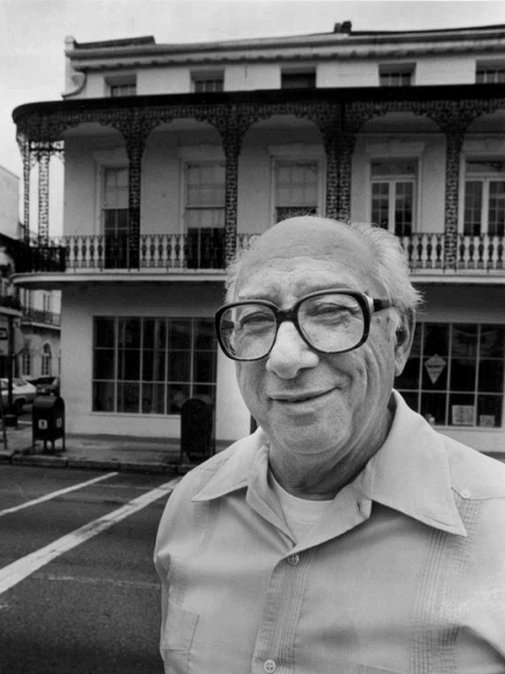
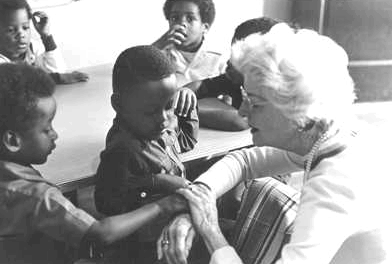 Story by Shannon Frystak
Story by Shannon Frystak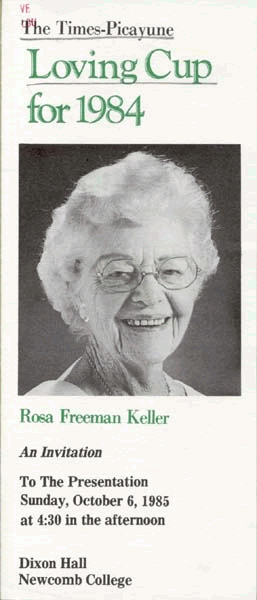 Rosa Freeman was born March 31, 1911, to Alfred Bird “A.B.” Freeman and Ella West. While her mother descended
from a family of southern aristocrats, Rosa’s father was a salesman—a “nobody from nowhere”—until
he made a fortune with his fledgling Coca Cola business. With his success, the family gained entrance into the world of the
New Orleans elite. After high school, Rosa Freeman attended Sophie Newcomb College for a year and then, anxious to establish
her independence, transferred to Hollins College in Virginia, only to drop out a year later. At her social debut in New Orleans,
Rosa Freeman met Charles Keller II, whom she married in 1932. After a few itinerant years because of Charles’s work
in the armed services, the Keller family settled in New Orleans in 1944.
Rosa Freeman was born March 31, 1911, to Alfred Bird “A.B.” Freeman and Ella West. While her mother descended
from a family of southern aristocrats, Rosa’s father was a salesman—a “nobody from nowhere”—until
he made a fortune with his fledgling Coca Cola business. With his success, the family gained entrance into the world of the
New Orleans elite. After high school, Rosa Freeman attended Sophie Newcomb College for a year and then, anxious to establish
her independence, transferred to Hollins College in Virginia, only to drop out a year later. At her social debut in New Orleans,
Rosa Freeman met Charles Keller II, whom she married in 1932. After a few itinerant years because of Charles’s work
in the armed services, the Keller family settled in New Orleans in 1944. 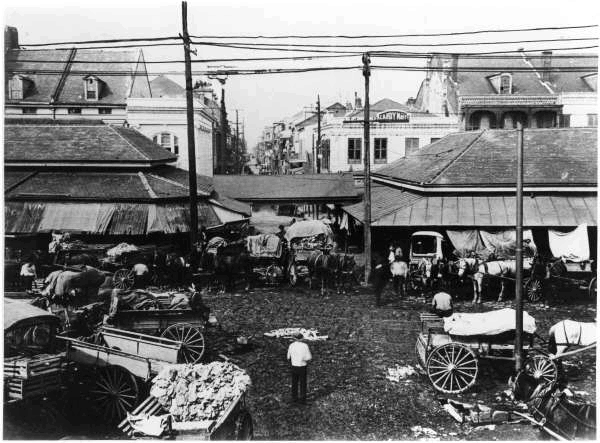
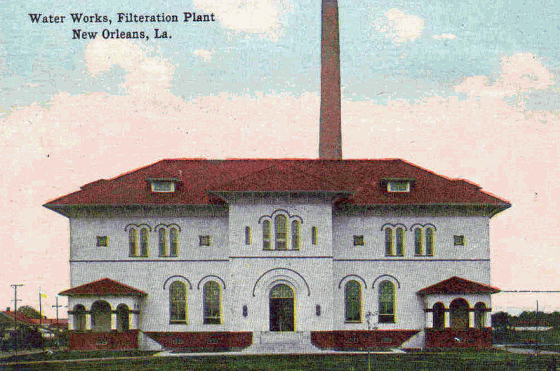 His first political association was as secretary of the Algiers Campaign Committee for Francis T. Nicholls in 1888. He later
became deputy assessor but lost this position due to a political turnover. He then went to work as a solicitor for the
Edison Electric Light Company but soon secured another political position, the assessorship for Algiers. For four years
he served as president of the Board of Assessors and then became clerk to three committees of the City Council during the
administration of Mayor John Fitzpatrick, 1892, 1896. He also was a member of the Orleans Parish School Board from 1982
to the time he became an ex-officio member in 1904. In 1898 he was one of the delegates to the Constitutional Convention.
His first political association was as secretary of the Algiers Campaign Committee for Francis T. Nicholls in 1888. He later
became deputy assessor but lost this position due to a political turnover. He then went to work as a solicitor for the
Edison Electric Light Company but soon secured another political position, the assessorship for Algiers. For four years
he served as president of the Board of Assessors and then became clerk to three committees of the City Council during the
administration of Mayor John Fitzpatrick, 1892, 1896. He also was a member of the Orleans Parish School Board from 1982
to the time he became an ex-officio member in 1904. In 1898 he was one of the delegates to the Constitutional Convention.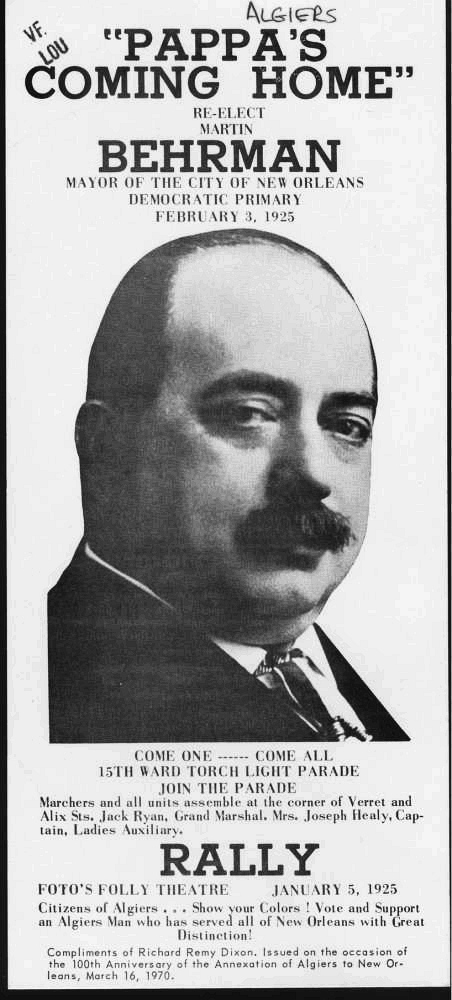 During Mr. Behrman’s long administration many old obstacles were overcome and the city made considerable progress in
improvements along various lines. The Sewerage System and the Purification Plant, whose six hundred miles of water mains
through which the finest and purest of water in the world was brought to the property line of 80,000 homes, were constructed.
The Public School System enjoyed great progress. The development of the Public Belt Railroad, the docks, Public Cotton
Warehouses and Elevators give credit to Mr. Behrman’s stewardship.
During Mr. Behrman’s long administration many old obstacles were overcome and the city made considerable progress in
improvements along various lines. The Sewerage System and the Purification Plant, whose six hundred miles of water mains
through which the finest and purest of water in the world was brought to the property line of 80,000 homes, were constructed.
The Public School System enjoyed great progress. The development of the Public Belt Railroad, the docks, Public Cotton
Warehouses and Elevators give credit to Mr. Behrman’s stewardship.
